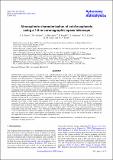| dc.contributor.author | Maire, Anne-Lise | |
| dc.contributor.author | Galicher, Raphael | |
| dc.contributor.author | Boccaletti, Anthony | |
| dc.contributor.author | Baudoz, Pierre | |
| dc.contributor.author | Schneider, Jean | |
| dc.contributor.author | Stam, Daphne | |
| dc.contributor.author | Cahoy, Kerri | |
| dc.contributor.author | Traub, Wes | |
| dc.date.accessioned | 2017-07-21T21:37:21Z | |
| dc.date.available | 2017-07-21T21:37:21Z | |
| dc.date.issued | 2012-05 | |
| dc.identifier.issn | 0004-6361 | |
| dc.identifier.uri | http://hdl.handle.net/1721.1/110810 | |
| dc.description.abstract | High-contrast imaging is currently the only available technique for the study of the thermodynamical and compositional properties of exoplanets in long-period orbits, comparable to the range from Venus to Jupiter. The SPICES (Spectro-Polarimetric Imaging and Characterization of Exoplanetary Systems) project is a coronagraphic space telescope dedicated to the spectropolarimetric analysis of gaseous and icy giant planets as well as super-Earths at visible wavelengths. So far, studies for high-contrast imaging instruments have mainly focused on technical feasibility because of the challenging planet/star flux ratio of 10-8-10-10 required at short separations (200 mas or so) to image cold exoplanets. However, the main interest of such instruments, namely the analysis of planet atmospheric/surface properties, has remained largely unexplored. Aims. The aim of this paper is to determine which planetary properties SPICES or an equivalent direct imaging mission can measure, considering realistic reflected planet spectra and instrument limitation. Methods. We use numerical simulations of the SPICES instrument concept and theoretical planet spectra to carry out this performance study. We also define a criterion on the signal-to-noise ratio of the measured spectrum to determine under which conditions SPICES can retrieve planetary physical properties. Results. We find that the characterization of the main planetary properties (identification of molecules, effect of metallicity, presence of clouds and type of surfaces) would require a median signal-to-noise ratio of at least 30. In the case of a solar-type star <10 pc, SPICES will be able to study Jupiters and Neptunes up to -5 and -2 AU respectively, because of the drastic flux decrease with separation. It would also analyze cloud and surface coverage of super-Earths of radius 2.5 Earth radii at 1 AU. Finally, we determine the potential targets in terms of planet separation, radius and distance for several stellar types. For a Sun analog, we show that SPICES could characterize Jupiters (M ≥ 30 Earth masses) as small as 0.5 Jupiter radii at ≤2 AU up to 10 pc, and super-Earths at 1-2 AU for the handful of stars that exist within 4-5 pc. Potentially, SPICES could perform analysis of a hypothetical Earth-size planet around a Cen A and B. However, these results depend on the planetary spectra we use, which are derived for a few planet parameters assuming a solar-type host star. Grids of model spectra are needed for a further performance analysis. Our results obtained for SPICES are also applicable to other small (1-2 m) coronagraphic space telescopes. | en_US |
| dc.language.iso | en_US | en_US |
| dc.publisher | EDP Sciences S.A. | en_US |
| dc.subject | atmospheric characterization | en_US |
| dc.subject | cold exoplanets | en_US |
| dc.subject | coronagraphic space telescope | en_US |
| dc.subject | high-contrast imaging instruments | en_US |
| dc.subject | thermodynamical properties | en_US |
| dc.subject | compositional properties | en_US |
| dc.subject | long-period orbits | en_US |
| dc.subject | Venus comparison | en_US |
| dc.subject | Jupiter comparison | en_US |
| dc.subject | SPICES project | en_US |
| dc.subject | spectropolarimetric analysis | en_US |
| dc.subject | icy giant planets | en_US |
| dc.subject | superEarths | en_US |
| dc.subject | visible wavelengths | en_US |
| dc.subject | planet/star flux ratio | en_US |
| dc.subject | planet atmospheric/surface properties | en_US |
| dc.subject | planet spectra | en_US |
| dc.subject | numerical simulations | en_US |
| dc.subject | SPICES instrument concept | en_US |
| dc.subject | signal-to-noise ratio | en_US |
| dc.subject | Neptuneshypothetical Earth-size planet | en_US |
| dc.subject | Cen A | en_US |
| dc.subject | Cen B | en_US |
| dc.subject | solar-type host star | en_US |
| dc.subject | size 1.5 m | en_US |
| dc.title | Atmospheric characterization of cold exoplanets using a 1.5-m coronagraphic space telescope | en_US |
| dc.type | Article | en_US |
| dc.identifier.citation | Maire, A.-L., R. Galicher, A. Boccaletti, P. Baudozl, J. Schneider, K. L. Cahoy, D. M. Stam, and W. A. Traub,“ Atmos- pheric characterization of cold exoplanets using a 1.5-m coronagraphic space telescope,” 541, A83, Astrono- my & Astrophysics, doi: 10.1051/0004-6361/201218954, 2012. | en_US |
| dc.contributor.department | Space Telecommunications Astronomy and Radiation (STAR) Lab | |
| dc.contributor.department | Massachusetts Institute of Technology. Department of Aeronautics and Astronautics | |
